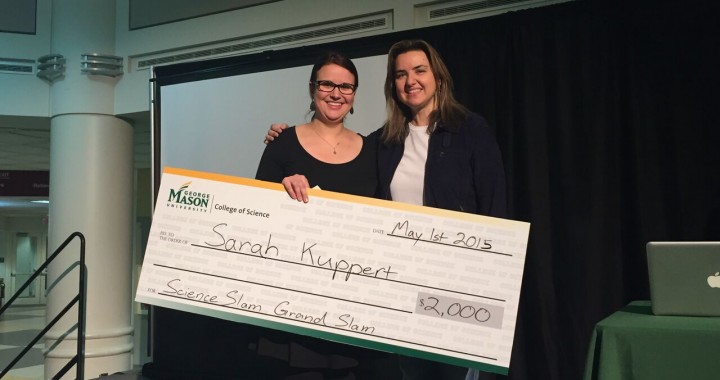by Sarah Kuppert, a recent graduate of George Mason University’s Department of Environmental Science and Policy, and Coordinator of the Chesapeake Bay SCI
A common criticism of scientists is that they are unable to communicate their research to non-scientists. Yet, communication is one of the most important skills a scientist can possess, as discoveries are only going to make an impact when they can reach their target audience. Training aspiring scientists in the art of public speaking is an absolute necessity and will become increasingly important in an age where online presence is a must. Though public speaking is a daunting undertaking for those who do not give regular presentations, regularly practicing this skill can make novices more comfortable.
Science Slams, a competition format that was invented in Germany, present an opportunity for students to practice public speaking. In these competitions, students give short, comedic presentations about their research. The goal is to solicit the most laughter and applause from the audience, though scientific integrity and accuracy are expected. In addition to letting students practice talking to a broad, non-scientifically literate audience, the students can win grants, add an impressive accomplishment to their resumes, and learn about the research conducted in other departments.
In May at the Science Slam at George Mason University, I presented my research on detecting salamanders with molecular methods. While I had given countless presentations to classmates and peers in my field, it was a completely novel experience to explain my somewhat complicated research to a lay audience. In addition to that, trying to be funny on stage was something I had never done before and it seemed terrifying at first.
The competition was structured into three separate events, two preliminary rounds and a final round. The first, second, and third place contestants from the first two rounds eventually competed in the final round, the Grand Slam. In between rounds, the contestants could watch speaker videos that were recorded during the preliminary rounds and revise their presentations. Watching yourself on video was a helpful review tool to many of the presenters, allowing them to review the flow of their presentations, study their posture, and focus on articulation. Trying to explain the research in as basic terms as possible can also help the presenters to gain a deeper level of understanding of the research topic, because the use of jargon is not encouraged. Instead, presenters have to find simpler ways to explain underlying concepts.
In George Mason University’s Science Slam, I ended up winning both the preliminary round and the Grand Slam. I won a total of $2,500 – a significant amount for two ten-minute presentations. Looking back, I am grateful for this challenge and excitement, as it boosted my confidence in my speaking abilities. As a recent graduate with a Master’s in Environmental Science and Policy, having won a prize for public speaking is a skill that sets me apart from the large and competitive pool of job applicants. This experience was one of the highlights of my graduate school career and I believe it is an excellent format for giving a public speaking opportunity, connecting graduate students from different departments, involving the public, and for giving students the opportunity to win grant money.
Photo credit: Eric Hawkins

